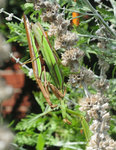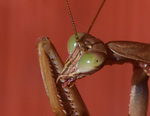 Narrowsburg
NarrowsburgLight Rain Fog/Mist, 43°
Wind: 8.1 mph
 Narrowsburg
NarrowsburgAlthough it is starting to get cooler, late summer and early fall is a good time to find assorted insects. Many insects that don’t overwinter in their larval state are near full size and ready …
Stay informed about your community and support local independent journalism.
Subscribe to The River Reporter today. click here
This item is available in full to subscribers.
Please log in to continue |



Although it is starting to get cooler, late summer and early fall is a good time to find assorted insects. Many insects that don’t overwinter in their larval state are near full size and ready to mate and lay eggs. They are easier to spot due to their size but also can be spotted due to their breeding activity.
Praying mantises are one of these insects. Now is the time that males will find a receptive female to mate with. Soon after, the female will deposit an egg mass (called an ootheca) on a plant stem or branch. This mass, which has the consistency of Styrofoam, may contain up to 400 eggs.
Mantises are well camouflaged, but two together are easier to spot than a solitary insect. Of the four mantis species present in PA, two of them are more common in this region: The larger of the two mantis species, the Chinese mantis (Tendodera sinensis), measures around five inches. The European Mantis (Mantis religiosa) is smaller, about 2.5-inches. The Chinese mantis is the species featured in the images for this week’s column and are more numerous than the other species of mantids.
If you spot mating mantises, you may wonder if the rumor that the male mantis will be eaten by the female afterward holds water. While this sometimes happens in the wild, it is not often that the male gets eaten after copulation. This behavior is more seen by people who breed and sell mantises for biological control, as the male and female are in an enclosure of some type. Breeders have learned to separate the pair after mating and to make sure the female is well-fed beforehand.
Comments
No comments on this item Please log in to comment by clicking here